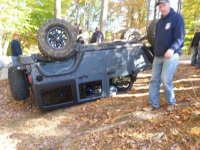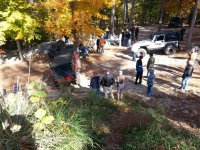You are using an out of date browser. It may not display this or other websites correctly.
You should upgrade or use an alternative browser.
You should upgrade or use an alternative browser.
Recovering from a roll over
- Thread starter MR.Ty
- Start date
JKbrick
Active Member
I would drain the engine oil, and pull the spark plugs and crank the motor to get the excess fluids out of the cylinders. I'm sure there are other things but that would be some of the first things i did before restart.
I don't think I'd crank the engine after I drained out the oil but I would definitely pull the plugs and turn it over
Jiffy05
New member
Sooo total noob question. Do you need a special tool to pull the spark plugs?
Loading please wait....
Just a spark plug socket with a magnet or a rubber piece inside it.
GCM 2
New member
KFirst- shut the ignition off ASAP (even during the flop if possible). Prepare for fire, get the extinguishers handy.
Second- evaluate injuries to people or pets. Attend to those first, forget about the stupid paint, metal and rubber damage.
Three- recover the vehicle. This is as dangerous or more dangerous than the initial flop. This takes a lot of knowledge to right vehicle without causing further damage. The use of winch blocks is highly advisable to lessen the work on the winches doing the recovery, it also makes it much more controllable up until the point of gravity taking back over. Doing this type of recovery is exceptionally technical and actually is very helpful if you have had professional lessons/training.
Four- once vehicle is righted, a seriously detailed assessment of the damage to the engine needs to be done before attempting to restart.
Five- No need to drain the oil! That serves no other purpose other than to make the trail even more messy. However, you do need to pull the spark plugs to release any vacuum in the cylinders that might be keeping oil from returning back into the pan from the cylinders. Also pull the air filter to see if oil has made it up through the intake manifold and all the way to the filter element.
Six- once it has been deemed safe to attempt an engine turn over, and with the plugs still out, crank the engine over to purge the cylinders of oil. Caution: this is super messy, oil is going to spray everywhere.
Seven- Once the cylinders seem dry of oil, clean all the spark plugs with brake cleaner really well. Reinstall spark plugs, check engine oil level on as flat a surface as possible and top off. Top off all other fluids too at this point.
Eight- start vehicle, prepare for lots of smoke......which will eventually go away. Now drive off trail.
Caveat: it is possible that you may not have to pull plugs, but this is an advance technique to check if motor is hydro-locked, but I will not cover that here.
For all you newer guys here on the forum, during the pre-run for the King of the Hammers 2013 race, my jeep was flopped on the first day of the run. Basically using the outline above, we recovered the jeep, finished pre-running that day and the next day too and then I drove the 435 miles from Johnson Valley back to Scottsdale, AZ
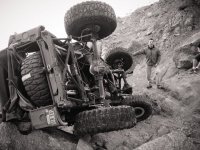
View attachment 110885
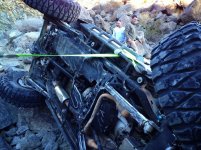
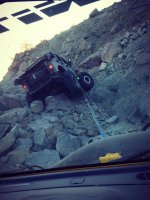
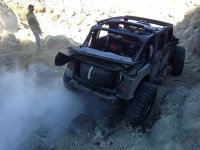
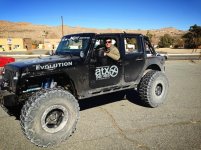
Second- evaluate injuries to people or pets. Attend to those first, forget about the stupid paint, metal and rubber damage.
Three- recover the vehicle. This is as dangerous or more dangerous than the initial flop. This takes a lot of knowledge to right vehicle without causing further damage. The use of winch blocks is highly advisable to lessen the work on the winches doing the recovery, it also makes it much more controllable up until the point of gravity taking back over. Doing this type of recovery is exceptionally technical and actually is very helpful if you have had professional lessons/training.
Four- once vehicle is righted, a seriously detailed assessment of the damage to the engine needs to be done before attempting to restart.
Five- No need to drain the oil! That serves no other purpose other than to make the trail even more messy. However, you do need to pull the spark plugs to release any vacuum in the cylinders that might be keeping oil from returning back into the pan from the cylinders. Also pull the air filter to see if oil has made it up through the intake manifold and all the way to the filter element.
Six- once it has been deemed safe to attempt an engine turn over, and with the plugs still out, crank the engine over to purge the cylinders of oil. Caution: this is super messy, oil is going to spray everywhere.
Seven- Once the cylinders seem dry of oil, clean all the spark plugs with brake cleaner really well. Reinstall spark plugs, check engine oil level on as flat a surface as possible and top off. Top off all other fluids too at this point.
Eight- start vehicle, prepare for lots of smoke......which will eventually go away. Now drive off trail.
Caveat: it is possible that you may not have to pull plugs, but this is an advance technique to check if motor is hydro-locked, but I will not cover that here.
For all you newer guys here on the forum, during the pre-run for the King of the Hammers 2013 race, my jeep was flopped on the first day of the run. Basically using the outline above, we recovered the jeep, finished pre-running that day and the next day too and then I drove the 435 miles from Johnson Valley back to Scottsdale, AZ

View attachment 110885




Last edited:
MR.Ty
Token East Coast Guy
Wow thank you for that info and background story.
So I am guessing it is a good idea to add things to my tool bag like: Oil (to top off with), air filter, something to pull the spark plugs with, kitty litter to clean up the oil with. Edit: and a fire extinguisher.
More noob questions: Do how do you crank the engine over....
Loading please wait....
Last edited:
GCM 2
New member
Wow thank you for that info and background story.
So I am guessing it is a good idea to add things to my tool bag like: Oil (to top off with), air filter, something to pull the spark plugs with, kitty litter to clean up the oil with. Edit: and a fire extinguisher.
More noob questions: Do how do you crank the engine over....
Loading please wait....
Well, the level of wheeling we do out here in the west is often pretty extreme and if everyone carries a few extra quarts of oil, water/antifreeze, powersteering fluid, diff fluid and a decent selection of tools, there will usually be more than enough supplies to fix someone who had a bad day.
So yes, you are definitely a noob :cheesy: Now this is pretty technical and I'm guessing you mean "crank the engine over" when the plugs are out. I will see if I can dumb this down enough.....insert the key into the ignition and try to start the vehicle! That simple, it won't start because there are no plugs to help compression build and then fire the compressed mixture of fuel and air, so the engine just spins freely. Too easy
Last edited:
MR.Ty
Token East Coast Guy
So yes, you are definitely a noob :cheesy: Now this is pretty technical and I'm guessing you mean "crank the engine over" when the plugs are out. I will see if I can dumb this down enough.....insert the key into the ignition and try to start the vehicle! That simple, it won't start because there are no plugs to help compression build and the fire the compressed mixture of fuel and air, so the engine just spins freely. Too easy.
I dunno... that sounds like a really advanced maneuver. Nothing about that seems easy. :cheesy:
Serious note: Thank you for taking the time to answer my questions. :thumbup::beer:
Loading please wait....
OverlanderJK
Resident Smartass
KFirst- shut the ignition off ASAP (even during the flop if possible). Prepare for fire, get the extinguishers handy.
Second- evaluate injuries to people or pets. Attend to those first, forget about the stupid paint, metal and rubber damage.
Three- recover the vehicle. This is as dangerous or more dangerous than the initial flop. This takes a lot of knowledge to right vehicle without causing further damage. The use of winch blocks is highly advisable to lessen the work on the winches doing the recovery, it also makes it much more controllable up until the point of gravity taking back over. Doing this type of recovery is exceptionally technical and actually is very helpful if you have had professional lessons/training.
Four- once vehicle is righted, a seriously detailed assessment of the damage to the engine needs to be done before attempting to restart.
Five- No need to drain the oil! That serves no other purpose other than to make the trail even more messy. However, you do need to pull the spark plugs to release any vacuum in the cylinders that might be keeping oil from returning back into the pan from the cylinders. Also pull the air filter to see if oil has made it up through the intake manifold and all the way to the filter element.
Six- once it has been deemed safe to attempt an engine turn over, and with the plugs still out, crank the engine over to purge the cylinders of oil. Caution: this is super messy, oil is going to spray everywhere.
Seven- Once the cylinders seem dry of oil, clean all the spark plugs with brake cleaner really well. Reinstall spark plugs, check engine oil level on as flat a surface as possible and top off. Top off all other fluids too at this point.
Eight- start vehicle, prepare for lots of smoke......which will eventually go away. Now drive off trail.
Caveat: it is possible that you may not have to pull plugs, but this is an advance technique to check if motor is hydro-locked, but I will not cover that here.
For all you newer guys here on the forum, during the pre-run for the King of the Hammers 2013 race, my jeep was flopped on the first day of the run. Basically using the outline above, we recovered the jeep, finished pre-running that day and the next day too and then I drove the 435 miles from Johnson Valley back to Scottsdale, AZ
 .....
.....JAGS
Hooked
KFirst-
Second-
Three-
Four-
Five-
Six-
Seven-
Eight-
Caveat:
That is an awesome step by step. Thank for that Greg. :thumb: I just printed out the post and am going to throw it in with my trail tools. I hope to never need it, but certainly helpful to have on the trail for myself or to help others.
GCM 2
New member
I'm kind of a big deal in southwestern Colorado, you may have heard of me, SoK66......
GCM 2
New member
I dunno... that sounds like a really advanced maneuver. Nothing about that seems easy. :cheesy:
Serious note: Thank you for taking the time to answer my questions. :thumbup::beer:
Loading please wait....
You got it Mr. Ty, no problems brother :thumb:
TheDuff
Caught the Bug
I'm kind of a big deal in southwestern Colorado, you may have heard of me, SoK66......
I think I have heard of you! Your like 70 right? And think every Asian dude in a white jk is Eddie?
Sent from my LG-D800 using WAYALIFE mobile app
KFirst- shut the ignition off ASAP (even during the flop if possible). Prepare for fire, get the extinguishers handy.
Second- evaluate injuries to people or pets. Attend to those first, forget about the stupid paint, metal and rubber damage.
Three- recover the vehicle. This is as dangerous or more dangerous than the initial flop. This takes a lot of knowledge to right vehicle without causing further damage. The use of winch blocks is highly advisable to lessen the work on the winches doing the recovery, it also makes it much more controllable up until the point of gravity taking back over. Doing this type of recovery is exceptionally technical and actually is very helpful if you have had professional lessons/training.
Four- once vehicle is righted, a seriously detailed assessment of the damage to the engine needs to be done before attempting to restart.
Five- No need to drain the oil! That serves no other purpose other than to make the trail even more messy. However, you do need to pull the spark plugs to release any vacuum in the cylinders that might be keeping oil from returning back into the pan from the cylinders. Also pull the air filter to see if oil has made it up through the intake manifold and all the way to the filter element.
Six- once it has been deemed safe to attempt an engine turn over, and with the plugs still out, crank the engine over to purge the cylinders of oil. Caution: this is super messy, oil is going to spray everywhere.
Seven- Once the cylinders seem dry of oil, clean all the spark plugs with brake cleaner really well. Reinstall spark plugs, check engine oil level on as flat a surface as possible and top off. Top off all other fluids too at this point.
Eight- start vehicle, prepare for lots of smoke......which will eventually go away. Now drive off trail.
Caveat: it is possible that you may not have to pull plugs, but this is an advance technique to check if motor is hydro-locked, but I will not cover that here.
For all you newer guys here on the forum, during the pre-run for the King of the Hammers 2013 race, my jeep was flopped on the first day of the run. Basically using the outline above, we recovered the jeep, finished pre-running that day and the next day too and then I drove the 435 miles from Johnson Valley back to Scottsdale, AZ
Sheesh!! And here I was thinking I could come in here and post up a response :doh: :rolleyes2: :crazyeyes:
Seriously folks, this is about as good of an answer as it gets. Greg, if you're cool with it, I'd like to modify it a bit so that it can stand alone as it's own post. I'd like to make it a stickied article that people can reference.
Rccrwlr
New member
Somewhere in there should be "separate ass from seat" because for most of us, a flop or roll will result in the buttocks doing a quick upholstery inhale.
Great info GCM2!
This is the only extraction I can think of to actually purchase a 12,000 pound winch.

